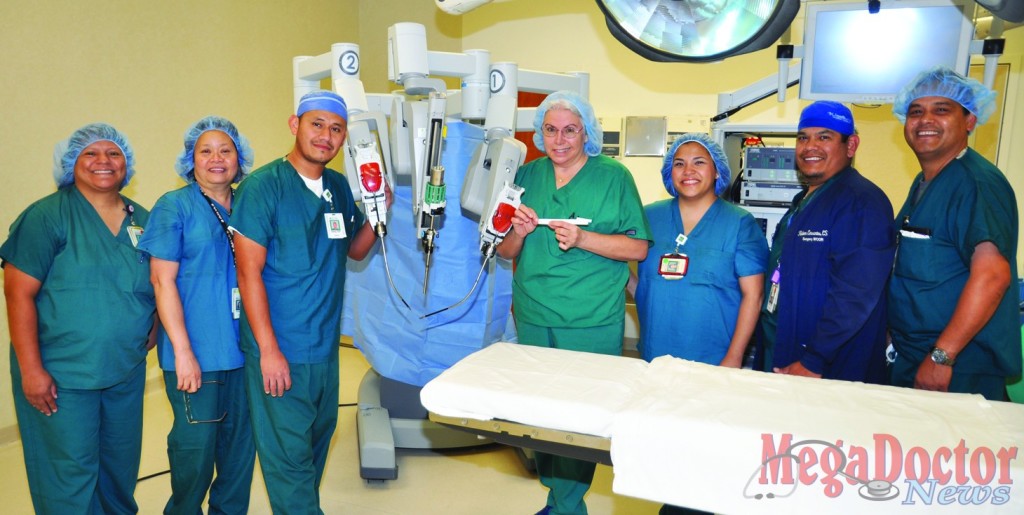
Mega Doctor News
Harlingen — Dr. Susan Hunter, Gynecologic Surgeon, has performed the Valley’s first robotic-assisted hysterectomy (removal of the uterus) surgery through a single small incision in a patient’s navel (belly button), using a new type of surgical instrumentation.
Dr. Hunter used the “single-site” da Vinci® ‘Si’ robotic surgical system at Valley Baptist Medical Center in Harlingen to perform the surgery for a Valley woman in her forties who was suffering from pelvic pain and abnormal menstrual bleeding, and had a large cyst in one of her ovaries. The entire surgery was performed through one incision, one inch long, in the patient’s belly button.
“Because of this, the patient went home the same day as her hysterectomy, with a small, barely-visible scar,” Dr. Hunter said. “That’s the nice thing for patients: faster recovery, less pain, and it’s very inconspicuous, so it looks better, cosmetically.”
The “single-site” surgery is considered virtually “scar-less”, because after the patient recovers, the scar in the navel is recessed, and very difficult to see in many cases.
Under the old traditional “open surgery” method with a larger incision, the patient would have had to spend three or four days in the hospital, Dr. Hunter said.
“Single-site robotic-assisted surgery enables these women to return sooner to their families, normal activities and jobs – saving them time and money in many cases,” Dr. Hunter added.
Although not all women are candidates for the single-site robotic procedure, Dr. Hunter said that many women are candidates for other small-incision options. She noted there are many benefits, in many cases, for those women who are able to have their surgeries with the less-invasive techniques.
Specially-trained surgeons on the Valley Baptist medical staff use the robot as an extension of their own hands to perform minimally-invasive surgeries for patients with gynecological, urological, gallbladder, gastric reflux and other conditions — including for treating cancer patients, such as women with cervical and uterine cancer, and men with prostate cancer.
During the procedure, Dr. Hunter guides the robotic arms which provide a high precision method to perform surgery through a tiny incision. The robot doesn’t move on its own.
“The robot is really just a large tool which is controlled by myself, the physician, at all times,” Dr. Hunter said. “It’s a way to be able to save women from the pain and suffering of a big incision, and from missing time away from work because of a major surgery.”
During the procedure, the surgeon operates while seated comfortably at a console viewing a three-dimension image of various parts of the body. Doctors insert surgical instruments and a camera through the small incision. The physician can precisely guide the instruments using high-definition monitors which greatly magnify extremely small areas inside the human body, displaying them in striking detail.
The robot also has an ‘endo-wrist’ which gives the doctor more flexibility in small places and enables more precise suturing. The system seamlessly translates the surgeon’s hand, wrist and finger movements into precise, real-time movements of surgical instruments inside the patient.
“The robot allows us to do more delicate and precise procedures than can be done by any other method, such as open surgery or laparoscopic surgery,” Dr. Hunter said. “In many cases, this means there is less bleeding and pain for the patient … it is a great thing for the people of the Valley to have the robot here and to have physicians with the ability to utilize this cutting-edge technology.”
In addition to hysterectomies for cancerous and non-cancerous uteri, Dr. Hunter was the first physician in Cameron County to perform several other gynecological procedures using the robot, including the first removal of an ovarian cyst (in which a large non-cancerous cyst was removed to save the ovary in a young girl); the first procedure to remove benign tumors (called fibroids) which can cause pain and bleeding in a patient’s uterus; the first robotic tubal reconstruction procedure which enabled a Valley woman to be able to successfully conceive and give birth to a child; and the first “prolapse” surgery (vaginal / pelvic reconstruction for a “fallen” vagina). MDN










